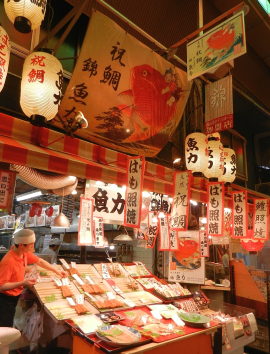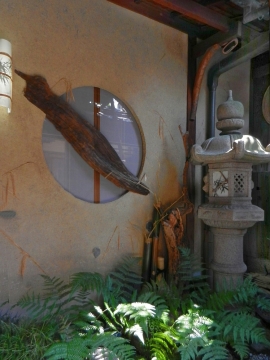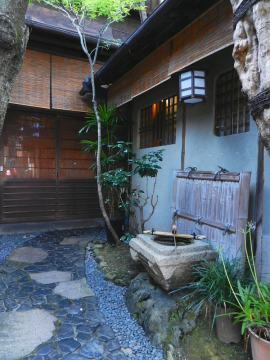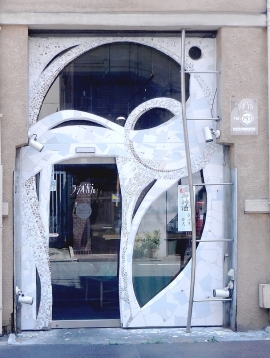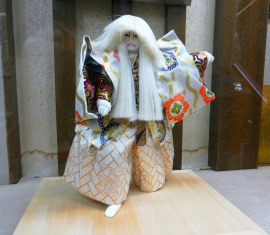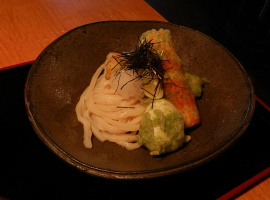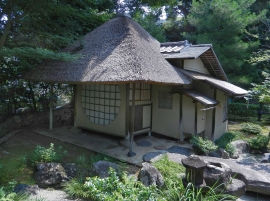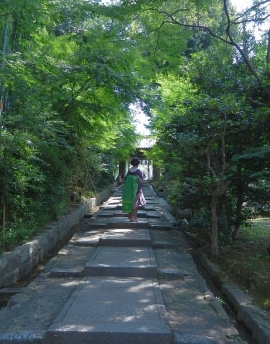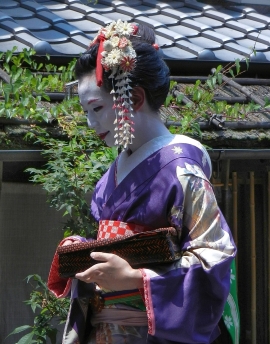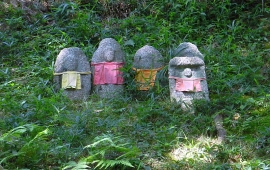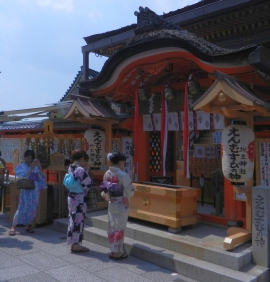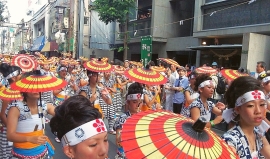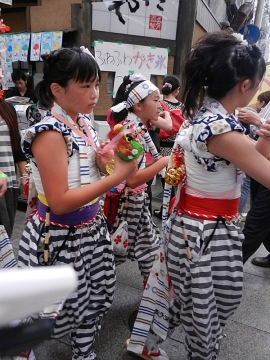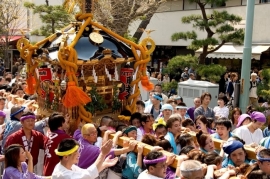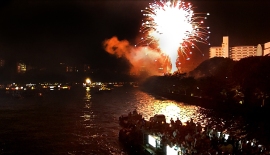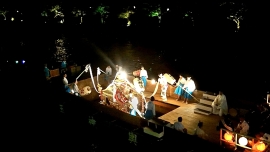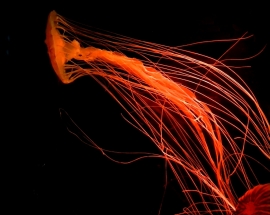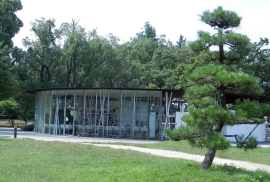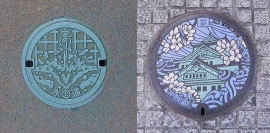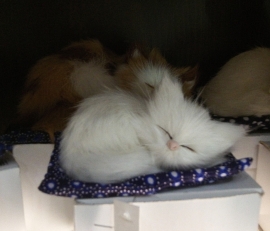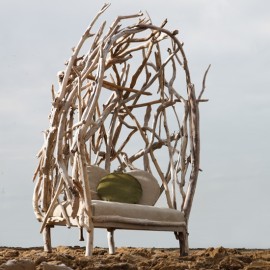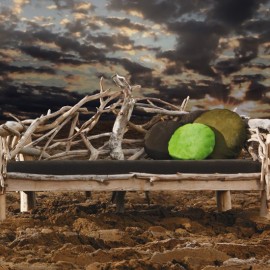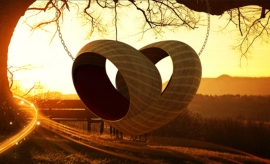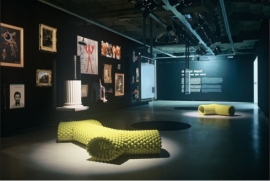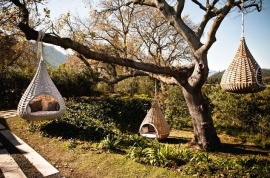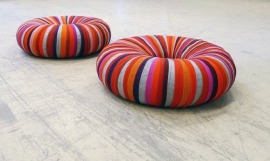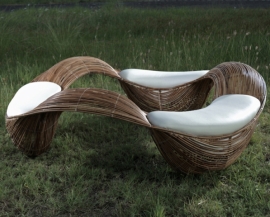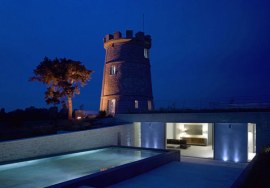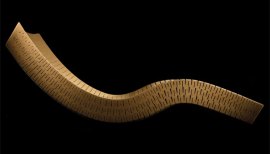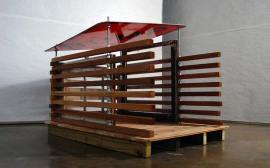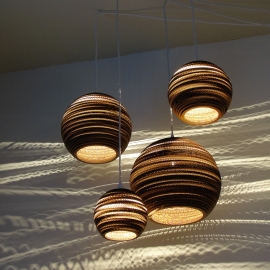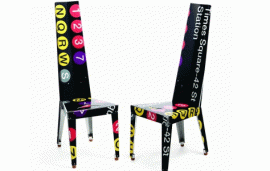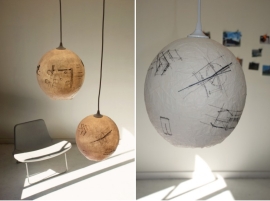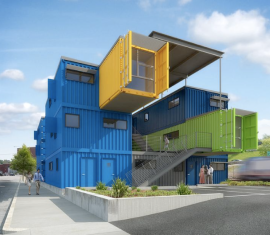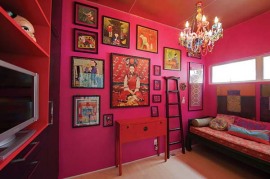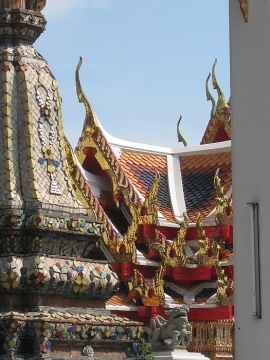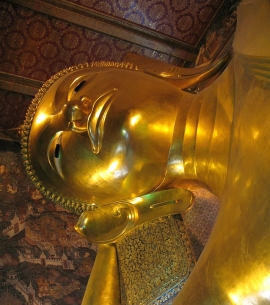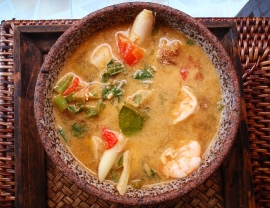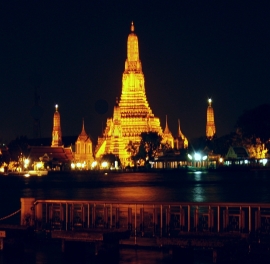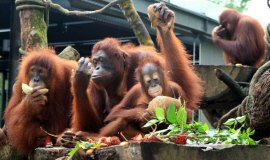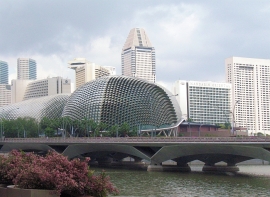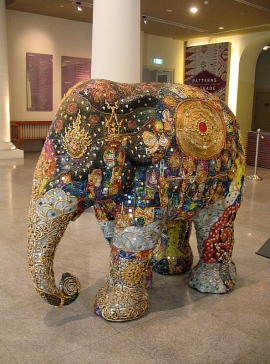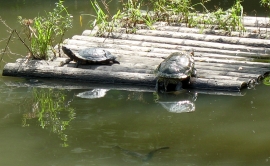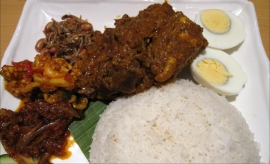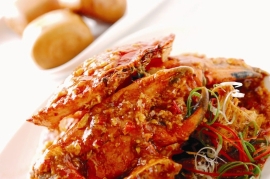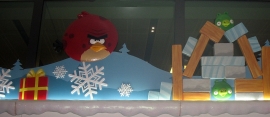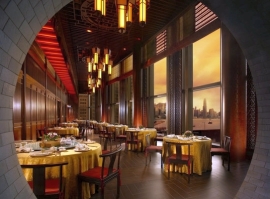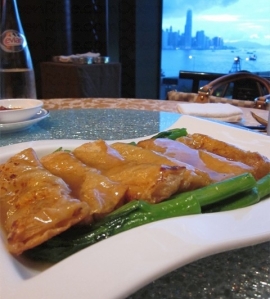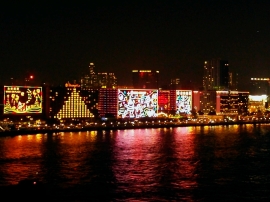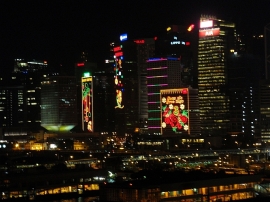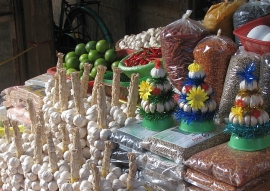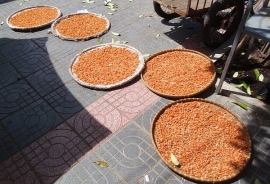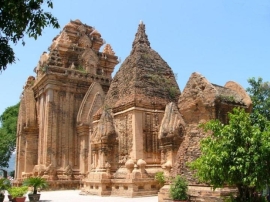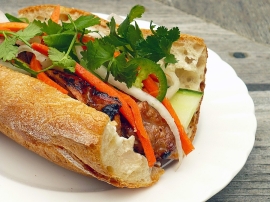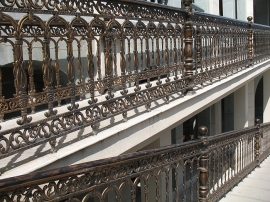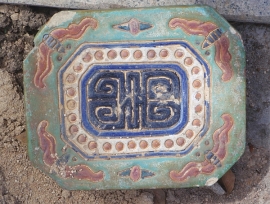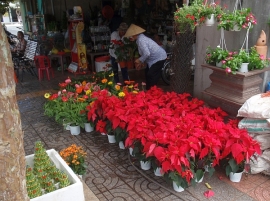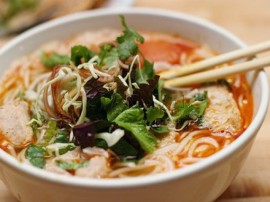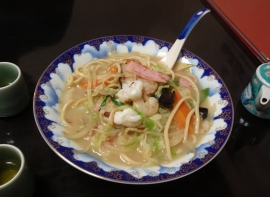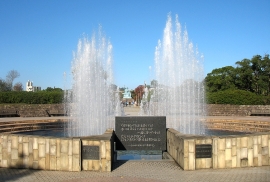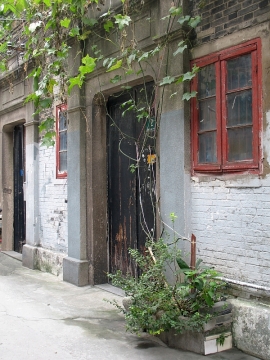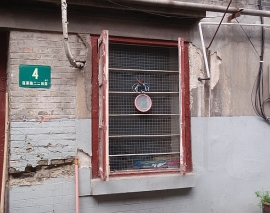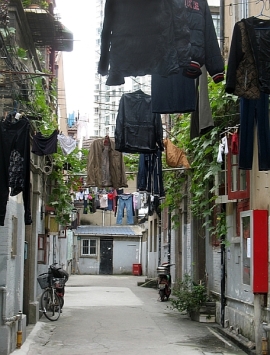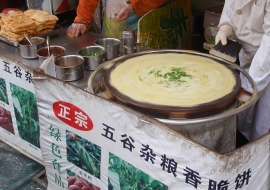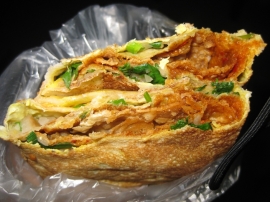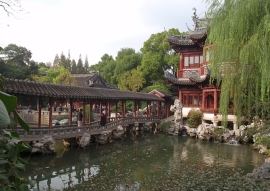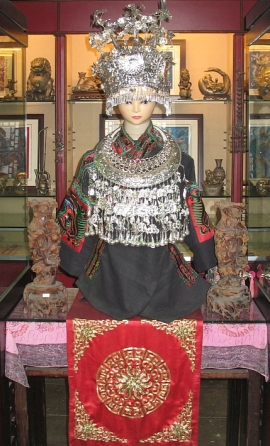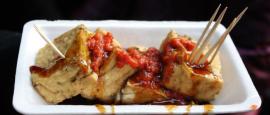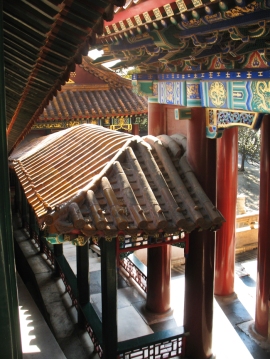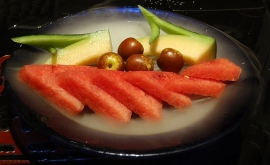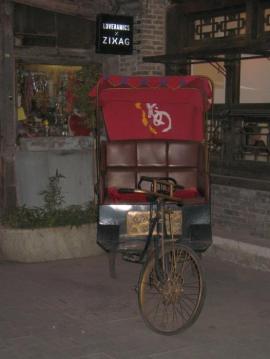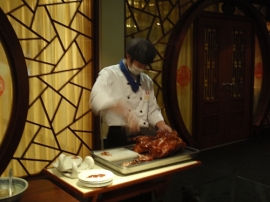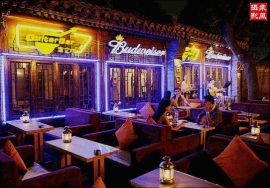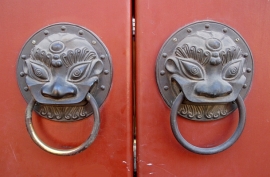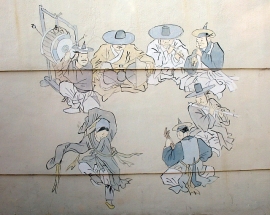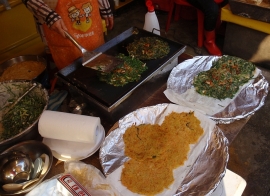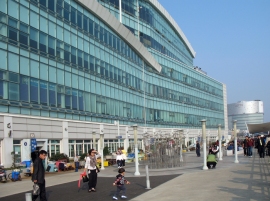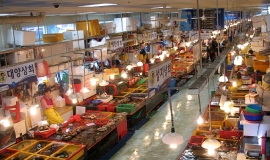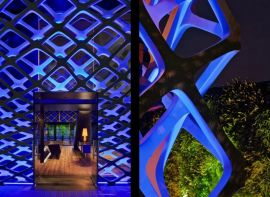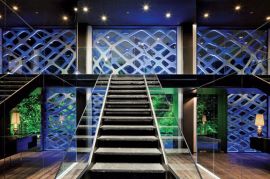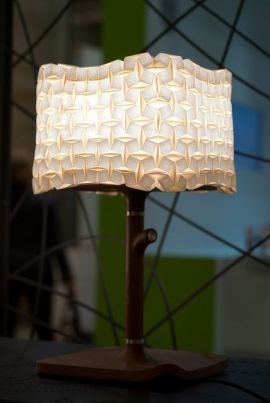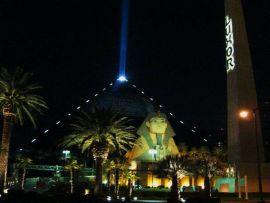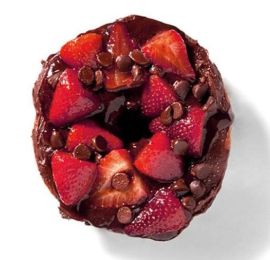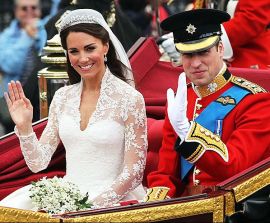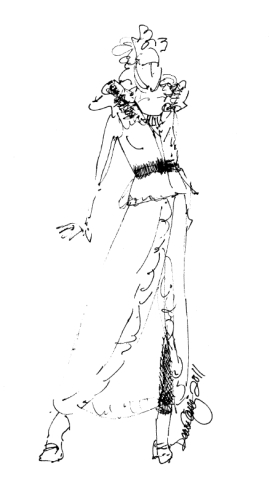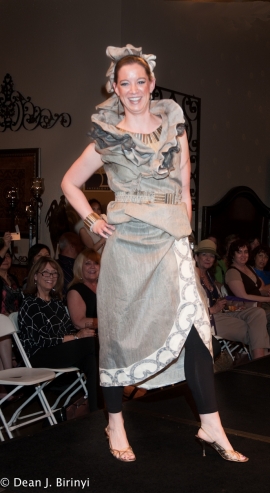Interior Design Diva
Musings on Design & InnovationJapan – Land of Spectacular Festivals, Foods & Castles – Kyoto
Our next stop, Kyoto, is a short train ride from Osaka. Once we arrived at our ryokan (traditional Japanese inn), we were treated to a private tea ceremony demonstration by the owner. She graciously explained the ritual and shared her pride in the quality of her matcha (powdered green tea), ceramics, and utensils. It’s a cultural experience not to be missed!
After checking in, we headed for the Nishiki Market, a covered shopping area, to hunt for souvenirs.
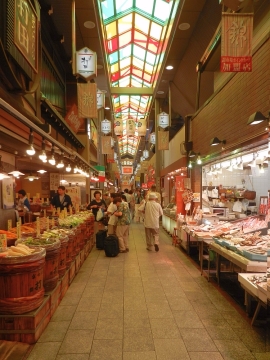
The centuries old Nishiki Market is also called ‘Kyoto’s Kitchen’ with more pickles than you can shake a daikon at!
The narrow 5-block street is chock-a-block with over a hundred traditional Japanese food shops and eateries. It was a sea of local seafood (fresh and dried), meat, snacks, produce and cookware.
The market stalls are festooned with banners and lanterns. While it’s not quite like Costco, free samples, especially pickles and snacks, are available at many stores.
A potential dinner choice, I was charmed by the eatery’s delightful contrast of textures and shapes between the weathered wood, smooth glass and straw-decorated plaster.
The serene setting is enhanced by the water vessel and carefully placed rocks on the walkway.
For a totally Western aesthetic, check out the elaborate tile and metal work of this bar!
I saw some houses with charms above their doors. This one, written in kanji (traditional Chinese characters) states the family name and seeks to invite good luck while warding off misfortune.
This beautiful doll shows a Kabuki actor with the white wig and traditional makeup used for the performance of Kagami Jishi or Dance of the White Lion.
Hungry and thirsty from roaming the neighborhood, we stumbled upon this noodle shop.
My refreshingly cold udon had the delicately chewy texture of fresh made noodles, while the accompanying tempura was light and crisp.
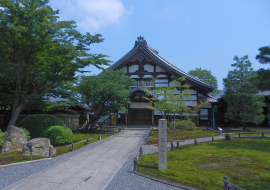
Memorial Hall of Kodaiji, a popular Buddhist temple in Higashiyama, Kyoto’s well preserved historic district.
Kodaiji was established in memory of Toyotomi Hideyoshi, the daimyo (warlord) who unified Japan at the end of the 16th century.
The goblin lanterns coordinated with the temporary painting exhibit we saw in the pavilion. It was a long scroll with a ghostly but humorous theme.
Enshu was instrumental in shaping the tea ceremony into a tradition that celebrates beauty in the most rustic or simple looking objects.
This tea house really exemplifies the Japanese aesthetic of wabi-sabi.
As we left Kodaji, I was really excited to see this Geisha go past us.
Since there was a photographer in tow, I wasn’t sure if she really was a geisha or just a model dressed up for the photo shoot.
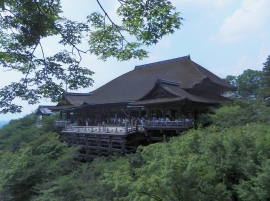
Kiyomizu-dera, literally Pure Water Temple, takes its name from the waterfall within the complex and is a UNESCO World Heritage site.
Kiyomizu-dera was constructed without the use of a single nail. The main hall is built over a cliff and features a large wooden veranda that is supported by 172pillars.
The popular expression “to jump off the verandah of Kiyomizu” is the Japanese equivalent of “taking the plunge”. Though banned in 1872, believers used to jump from the 45 foot platform hoping their wishes would come true if they survived!
There is a constant stream of visitors lining up to drink the water, which is believed to have wish-granting powers.
This being Japan, the long handled cups are returned to a sterilization rack which irradiates the cups after each use.
Our guide said these stone statues have aprons put on them at different times of the year.
On further research, it seems the statues represent Jizo, a powerful deity. The aprons are placed on the Jizos by parents who lost children in hopes that the god will protect their souls.
The Jishu shrine is in honor of the deity of love and matchmaking.
We saw plenty of kimono clad ladies or young couples who came to pray or have fortunes told. Better yet, anyone needing extra help can buy the good luck charms!
Japan – Land of Spectacular Festivals, Foods & Castles – Osaka Tenjin Matsuri, Day 2
We left for the Tenmangu Shrine after lunch on Day 2 of the Tenjin Matsuri. It was sweltering – and we were melting.
Our Goodwill Guide, Kiyoe, was incredibly well prepared – she brought us fans and frozen energy drinks that were intended to double as ice packs. We found the reusable bags so handy that we adopted the ritual of filling and freezing them daily for the rest of our trip!
To escape the heat we kept dodging into air conditioned establishments with any reasonable excuse. Kiyoe took us to an ice cream shop known for serving the cold treat with homemade plum jam. The slight tartness of the jam was very refreshing – but even more so was the AC!

We arrived at the Tenmangu shrine early and got a front row view of the taiko drum players, called Ganji, performing on a mobile platform (taiko-dai) as the procession emerged from the temple.
We didn’t quite realize being close to the action has its own hazards: tipping the platform is part of the happenings but sometimes get out of hand.
The taiko dai bearers set off a minor stampede when they got too rambunctious and crashed into the spectators, including us…
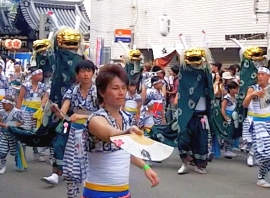
An impressive sight with 10 to 12 gold headed, white maned ‘Lions’ doing the lion dance (shishimai).
The lion dance compared to the Chinese version is much less acrobatic and colorful. As shown, the body drape is a rather simple green fabric. But that’s just fine as I find most of the polychromed Chinese lion costumes too exuberant.
The young ladies’ fresh voiced chanting amidst the sea of orange-yellow umbrellas make this a truly vibrant and charming dance.
The celebration was intended to create as much noise as possible in order to invoke the gods, so there were plenty of musical instruments, hand carried or on costumes, in the procession.
The mikoshi is taken out and returned each day of the festival. Considering that the floats are non-motorized, and Osaka in summer is brutal – about 90 F & 75% humidity – working the floats is no mean feat!
Like the Rose Bbowl Parade, some of the procession are on horseback and so there’s someone walking right behind them with a pooper scooper.
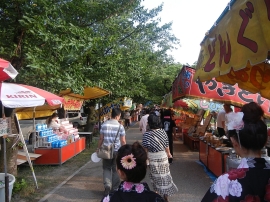
The banks of the O-kawa river are lined with stalls selling food, games, and … lots of little goldfish!
I had hoped to visit the stalls to try some Osaka street food. But we ran out of time, so I could only look at them longingly as we dashed towards the boat parade.
The festival is one of the times you see ladies all decked out in yukatas (summer kimonos), some augmented with fancy obis and hair pieces.
There were fireworks from 7:30 – 9 pm. We went with the crowds to the river. Luckily we found a great spot on the bridge to view the fireworks and boat parade (Funatogyo).
Here’s a great video by osakanight.com. It has amazing footage of the fireworks, as well as the sights and sounds of the festivities on the passing boats.
Most boats are sponsored by companies or community organizations, although there are tourist boats as well. It was surprising to see trees on some of the boats. In fact, they were actually tilted down by deck hands in order to go under the bridge!
The next day, we went to visit the Osaka Aquarium. It was a disappointment. The layout and animal feedings were poorly coordinated and for an aquarium of this size, the variety on display was unimpressive.
Apparently since it’s Japan, where real estate is at a premium, the exhibits are housed in a distinctly Japanese fashion – I felt sorry for the dolphins which seemed to be pacing inside the small tank!
Japan – Land of Spectacular Festivals, Foods & Castles – Osaka Tenjin Matsuri, Day 1
It’s July in Japan, hot as Hades and steamy as a sauna, but it’s also time for two awesome festivals: Tenjin Matsuri and Gujo Odori. Plus melt-in-the-mouth Hida beef & seasonal ayu fish kaiseki dinners await, how can I resist?
Over 1000 years old, Tenjin Matsuri in Osaka is one of the 3 biggest festivals in Japan. The highlight of the 2-day affair is a huge parade with thousands dressed in period costume carrying portable shrines, accompanied by music and dancing, culminating in a spectacular boat procession-cum-fireworks show the evening of July 25.
Another event, Gujo Odori in Gujo Hachiman, is one of the island nation’s most famous traditional dance festivals. For over 30 days in summer, dances take place all around town. The festival reaches a feverish pitch from August 13th to 16th, with dancing all night till wee hours (4-5 am!) in the morning!
On my 11-day trip, I enjoyed the sights & sounds of Osaka, Kyoto, Gifu as well as Gujo Hachiman, and came away with a greater appreciation for the rich culture of the Land of the Rising Sun. Here is the first installment of my adventures in Osaka – enjoy!
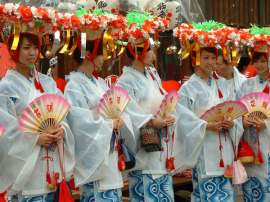
We didn’t get to see these exquisitely decked out Hana Musume (Flower Girls) who were out and about on the first day of the festival. This image was by ericlty.
Emblematic of the country’s amazing hospitality, Goodwill Guides offer volunteer guide services to visitors across Japan. Unfortunately because of our late afternoon arrival, we missed most of the happenings in the first day of the Tenjin Matsuri.
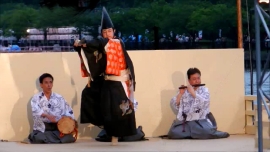
This special Noh is performed outdoors in the evening illuminated by bonfires.
Many kudos to Akira, our Goodwill Guide, who kindly volunteered to meet us at the airport so we could get to the festival site ASAP. His quick footwork got us to the Osaka Amenity Park in time to see this Takigi Noh performance.
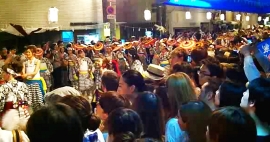
The kasa odori (umbrella dance) is an elegant dance that entails graceful twirling of the colorful umbrella while chanting. There was hardly any standing room as the crowds packed the sidewalks.
As host for the Tenjin Matsuri, the Tenmangu shrine is where rituals are performed and processions start & end.
We got to the temple just as the procession was returning. A column of young men performed the shishimai (lion dance) while hundreds of young ladies danced the kasa odori (umbrella dance), with co-ed bands playing traditional flutes and drums interspersed between them.
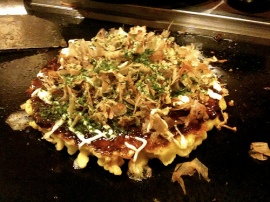
Hungry and tired, we stopped at a nearby restaurant for okonomiyaki, an Osaka specialty. Our pork version – which was cooked with slices of fat piggy – was very tasty indeed!
Okonomiyaki, also touted as ‘Japanese pizza’, is a mixture of seafood or meat, vegetables and batter cooked on a hot griddle, sometimes by the customer.
When done, the dish is topped with special sauce, mayonnaise, grated seaweed and bonito fish flakes which ‘dance’ eerily from the heat of the griddle.
Cool looking concession kiosk on the Castle grounds.
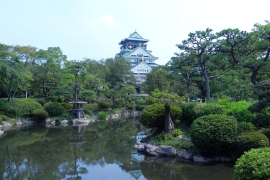
The Osaka Castle was first built in the 1580’s. With massive stone walls, black & gold-leaf trim and a copper roof, it remains one of Japan’s most famous castles.
Since the festival activities won’t start till late afternoon, we decided to visit the Osaka Castle and the oddly named Museum of Housing and Living. They gave different perspectives of Osaka’s past and made a pleasant morning excursion.

Cold buckwheat soba served with hot dipping sauce, wasabi, scallions and a fresh quail egg. A hot dipping sauce for cold noodles seemed counter intuitive, but it was one of the tastiest soba dishes I’ve ever had.
With the temperature in the stratosphere, I only felt like having cold noodles. We chanced upon this great noodle shop and had zaru soba with perfectly crisp shrimp, mushroom and pumpkin tempura. For the grand finale, hot stock was added to the dipping sauce after the noodles were finished and presto! we had a flavorful bowl of soup to round out our lunch!
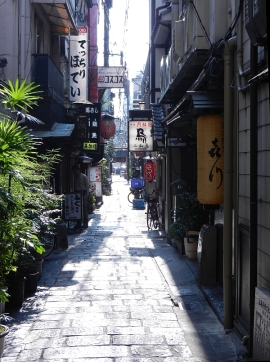
A traditional stone alley off Dotonbori street, the ‘restaurant row’ of Osaka.
This is the main tourist destination for food and entertainment.
Due to Osaka’s proximity to Kobe, we saw plenty of restaurants offering Kobe beef. Since real Kobe beef is not sold outside Japan, this is foodie heaven for serious carnivores!
These elaborate manhole covers, which double as street art, are from the Dotonbori area.
Sitting Pretty – Seating that’s Green & Nature Inspired
It’s summer and the emphasis largely shifts from indoors to the great outdoors. Here is a loose collection of seating that celebrates nature and all things green: it includes furniture derived from natural materials, nature inspired designs and even chairs or benches with ‘green creds’.
Some of the seating shown here is made of driftwood, wicker, rattan, or water hyacinth, which are either fast growing or abundantly available. In other cases, designs purposely emulate nature to conjure up its charms, while eco-friendly creations can boast of recycled content or fill sustainability goals.
Beautifully hand crafted by Bleu Nature, I imagine these are more conversation pieces than furniture intended for daily use. They don’t look very user-friendly, and can inflict serious damage to the unsuspecting’s body and clothes!
This romantically shaped rattan wrapped steel, crimson-upholstered swing for two is the creation of Mexican industrial designer Victor Alemán. It’s a perfect gift for one’s Valentine!
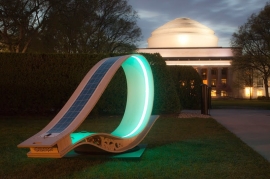
This is cool outdoor rocker generates power to recharge gadgets plugged into its three USB ports and to illuminate a light strip on the inside of the loop.
This hi-tech seating is developed by an MIT professor and a group of architecture students.
The rocker has a 35 W solar tracking system which helps it maximize solar power capture in the daytime. It also cleverly takes advantage of the kinetic energy generated from the rocking motion!
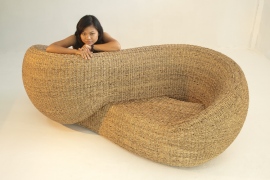
This armchair is made of rapidly renewable resources and is inspired by the Moebius strip, symbol of infinity ∞.
The environmentally friendly seating is made from water hyacinth and rattan to take advantage of their flexible (and rapidly renewable) properties.
It also uses natural dyes and natural latex in the cushions instead of synthetic foam.
The same material qualities that make tennis balls bright, bouncy and easy-to-spot make for seating that is comfortable, sturdy, and extremely eye-catching.
The seats are fashioned from a steel frame and dozens of tennis balls to bring a bit of color and bounce to the museum’s interior.
Designers Daniel Pouzet and Fred Frety used an industrial textile that’s weatherproof, pliable, strong, environmentally friendly, and supple enough to be woven.
These hanging lounges make interesting landscaping accents or meditation retreats. They are available in a variety of colors and materials in addition to the calming neutrals.
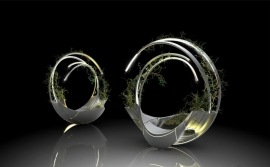
This Swiss Army Knife of This Swiss Army Knife of outdoor benches will amazingly create a self-sustaining system to both grow a green arbor above the seat AND light up the space!
Aside from collecting & filtering rainwater, the ec-O bench harnesses the sun’s energy with thin-film photovoltaics to provide power to light the bench at night.
Bio-Luminum tiles used are from salvaged parts of retired airplanes which are exceptionally durable and long lasting. Also specified is Bio-Glass which is engineered from recycled glass with no additives or colorants. Both materials qualify for LEED credit.
This is a functional work of art intended for mother and child to spend time reading or relaxing together.
Made of rattan and 100% hand crafted, the seating has an organic, modern look that will transform any space into a stylish oasis.
The colorful chair took its inspiration from the process behind making tassels.
It can be used with detachable stainless steel legs or used as a pouffe as shown. The design brings elements of childish delight and playfulness to this simplistic furniture form.
The furniture is made of rattan. Filipino designer Vito Selma took advantage of the highly renewable material’s resilient properties to create this seating reminiscent of waves crashing against the surf.
Upcycle & Repurpose: Everything Old is New Again
Upcycling and repurposing is now au courant. Interior designers, architects and manufacturers have come together to create a cornucopia of beautiful products and innovative structures.
In fact sustainability and aesthetics are no longer either/or options as seen below!
Bio-Glass, with its unique fabrication process, offers a cleaner look than most recycled materials. Instead of the telltale glass chunks set in a binder, it has a unique crinkly texture that somewhat resembles sea-glass.
It is made from pre-consumer recycled glass, post-consumer glass bottles or a combination of both, and is 100% recyclable at end of life.
By adding an underground extension to the tower, the spacious living areas, sunken courtyard, swimming pool and sun terrace are all out of public view.
The tower offers stunning panoramas of the surrounding countryside and houses 4 bedrooms in addition to the front entrance.
What better to use in The Round Tower’s pool than a floating lounger? Here is a chaise that is constructed of reclaimed waste material from the bottle-stopper industry. Being made of cork, the seating offers a cool feature – it floats!
The non-toxic chairs are made with a marine-grade adhesive and a small amount of polyurethane makes the furniture suitable for indoor or outdoor use.
Architects Jon Junker and Seth Grizzle made the dog house from salvaged old windows behind the garage, together with scraps of wood from the basement and leftover cedar siding.
For the finishing touch, they found a sign left by a road crew and appropriated it for the dig house roof!
The lamps are stylish solutions for the mountains of cardboard we generate daily. Being handmade, they all vary in shape & size.
The lamps work with a variety of light bulbs and include energy saving LED and compact fluorescent options.
These eco-friendly lighting designs share similar sustainability goals.
These colorful highback chairs are made from recycled NYC Subway graphics on aluminum traffic signs, champagne corks and hardware.
Truly street art for the home, these edgy chairs are probably best admired as such, or used as high turnover seating. I imagine a run-in with the chairs will be a painful experience…
Ah these lighting fixtures so tug at the hearts of designers and architects!
We go through reams of sketch paper (or ‘flimsy’ as we call it, for obvious reasons) starting from our days at school. The sight of them connects with our core and bespeaks the essence of our trade. To upcycle the stacks of discarded flimsy is wickedly clever…
The 11,600 structure has 12 office spaces. In addition to using recycled steel in the form of containers, green creds include a high performance building envelope, ultra-efficient HVAC, energy recovery ventilation and daylight sensing light fixtures. For the outside, the site is designed to reduce storm water runoff.
The 2,600 sf home was built with used containers from China. The home’s vibrant décor belies its modest origins. Industrial designer Debbie Glassberg designed the home for herself.
The house sports a green roof, spray foam insulation, passive solar design, and geothermal heating – important features if you happen to live in Kansas City!
Destination Asia: Of Dragons & Spice and Everything Nice – Bangkok & Singapore
BANGKOK, THAILAND
Our next port is Laem Chabeng which required another 90+ minute bus transfer to Bangkok.
There are tons of things to see and do in this vibrant metropolis – from visiting its numerous wats (temples) to touring the Grand Palace and exploring the city’s klongs (canals). Of course you always have the option to shop and party till you drop!
Having been to Bangkok before, we decided to take a cooking class and just pack in whatever sightseeing we can.
Wat Pho is one of the largest and oldest wats in Bangkok. It is also known as the birthplace of traditional Thai massage.
A massage from the school is under $8, but obviously without any pampering or ambience!
We saw pairs of figures resembling ancient Chinese court officials and generals standing sentry by the gates. For variety, there were some guards in Western attire (looking to me like the Mad Hatter) which were supposed to represent Marco Polo.
The architecture in the temple grounds is a fusion of Indian, Chinese, Khymer and European influences, resulting in a visual texture that reflects the country’s rich cultural heritage.
At 141 ft long and 49 ft high, it is the world’s biggest reclining Buddha statue.
The statue is covered in gold leaf except for the bottoms of the proportionately monumental feet which are inlaid with mother-of-pearl illustrations of the 108 auspicious laksanas (characteristics) of the Buddha.
We booked an afternoon class at Silom Thai Cooking School. The half day session included a trip to the market and a 5-course menu which included a soup, 3 entrees, and my favorite Thai dessert – mango with sticky rice!
It was Thanksgiving Day and the class was a great culinary alternative to the obligatory turkey-n-stuffing dinner being proffered on the ship.
This tasty hot and sour prawn soup is a cinch to make so long as you have the right ingredients. Here is the recipe from my class:
Tom Yum Koong (Creamy Style) Serves 1-2
1 lemongrass, cut into pieces
10 pc sliced galangal ginger*
3 kaffir lime leaves, torn in half
1 straw mushroom, trimmed and quartered
1 red bird’s eye chili
½ tomato, thinly sliced
1 c chicken stock or water
½ c medium prawns, peeled & deveined
2 T coconut milk
¼ T lime juice
½ T fish sauce
½ T nam prik pow, roasted Thai chili paste**
1 T fresh coriander leaves, chopped
1 T green onions, chopped
1. Put lemongrass, galangal ginger, kaffir lime leaves, mushroom, chili and tomato in chicken stock and bring to boil. Cook till tender.
2. Add the prawns, cook till tender.
3. Add coconut milk, lime juice, fish sauce and Thai chili paste.
4. Serve hot and garnish with fresh coriander and green onions.
*There is no good substitution for galangal. You can get dried galangal from an Asian grocery store and resuscitate it in warm water.
**This is available in jars at Asian groceries.
After the class, we were able to take the ferry to the dock across the water and get this beautiful view of Wat Arun silhouetted against the skyline.
SINGAPORE
All good things must come to an end and we finally reached the destination of our cruise. We only had a couple days in Singapore to see the city up close and personal. It was a packed itinerary and unfortunately things didn’t quite work out as planned.
We were looking forward to our breakfast date with the orangutans at the Singapore Zoo but that required us to be at the zoo by 9 am the morning of our disembarkation.
It took much longer to get from the port to the hotel than expected and we couldn’t get to the zoo in time. So I consoled myself with a picture of what could have been…
Nicknamed ‘The Twin Durian’, the Singapore Convention Center & Esplanade Theaters look vaguely like two halves of the distinctive tropical fruit.
We found a pair of elaborately decorated elephants in the lobby of the Asian Civilizations Museum, the meeting point for the museum’s free multi-language guided tours.
Our knowledgeable docent really helped us appreciate the pan-Asia exhibits which were part of Singapore’s rich history and cultural diversity.
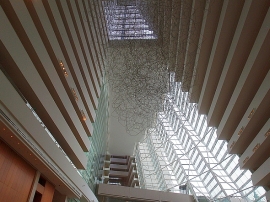
The Marina Bay Sands is an imposing architectural statement. Here is an inside view of one of the 3 soaring hotel towers.
The $8 billion Marina Bay Sands is the world’s most expensive standalone casino property. The resort, designed by famed architect Moshe Safdie, was purportedly inspired by card decks.
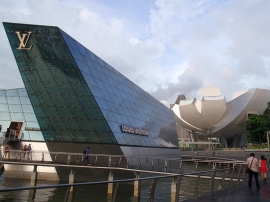
More marquee buildings on the resort grounds: the Louis Vuitton ‘island maison’ crystal pavilion dominates the foreground with the lotus-shaped ArtScience Museum as back drop.
These two buildings show totally different approaches towards light and architecture. The LV floating pavilion, being a glass structure, requires total and sophisticated sun control in order to sell the luxury goods.
The museum on the other hand is of glass fiber reinforced polymer formed into sculptural shapes. Skylights at the tips of the 10 ‘fingers’ illuminate the structure’s curved interior walls, creating an environment with very precise daylighting patterns.
We hired a birding guide for a half day trip to the Sungei Buloh Wetland Reserve. It is a richly diverse habitat.
Aside from seeing a nice variety of birds, we spied a monitor lizard and a croc along the river banks, an otter roll playfully in the sand, a deadly mangrove pit viper lurking in the tree canopy and two turtles hauling out onto a raft to catch some rays!
I had beef rendang at a Singaporean restaurant ages ago and it was love at first bite! After several failed attempts to replicate the recipe at home, I was bent on enjoying this labor intensive dish in Singapore.
It is a time consuming dish. While the prolonged cooking of the rich spices in coconut milk adds complexity to the flavors, the chunks of beef though fork tender, still retain a slightly chewy texture (no, it wouldn’t hurt anyone’s dentures…).
I tried it at every opportunity – from the gentrified food stations at the Marina Bay Sands, to local hawker stalls in the city and found the tastiest morsels at a no frills establishment by an industrial park compliments of our birding guide.
The flavorful beef served with lado (red chili sambal sauce), nasi lemak (rice cooked in coconut milk) and kopi ‘c’ (hot coffee with sweet evaporated milk) rounded out the simple but delicious meal.
We took the guide book’s recommendation and took a taxi to the UDMC Seafood Centre. It consists of two blocks of restaurants lining the road with their ground floors open to the sea.
Although chili crab and pepper crab are the two most popular dishes, all manner of seafood is available here fresh and is charged by weight.
We chose Jumbo Seafood by virtue of its air conditioning in the upstairs section. It sounds silly but then at the end of a long sweaty day, I decided to rearrange my priorities. The food was OK given its popularity with tourists and sheer size. Naturally we’ll be looking for other choices next time…
We got to the airport at the ungodly hour of 5 am for our flight home and were surprised to be greeted by Angry Birds in Holiday scenes over the airport entry doors. There is apparently no escape from the i-culture…
Destination Asia: Of Dragons & Spice and Everything Nice – Hong Kong & Vietnam
HONG KONG
Hong Kong was the next port of call. Considering roundtrip airfare runs about $1600 from the west coast, I was glad to take advantage of this ‘jet setting’ opportunity.
It was fun to drop in for a yummy brunch and hang out with my family for the day before hitting the high seas again in the evening!
Most popular restaurants on Hong Kong are packed cheek to jowl at lunch time, so your options to dine in relative peace are either at private clubs or hotel restaurants.
The food, despite being in a hotel, was surprisingly good and innovative: artfully crafted ‘goldfish dumplings’ were translucent skinned dumplings in shape of the namesake fish, the baked eel was full of crispy and fatty goodness, and stuffing savory minced duck into delicate teacup-sized sesame seed ‘pockets’ livened up the dining experience.
As the ship sailed past Hong Kong harbor, we made a video of the largest light show in the world (according to the Guinness Book of Records).
As lasers beam across the sky, buildings on both sides of the water sport festive holiday lights and color changing LEDs – it was a truly spectacular sight!
NHA TRANG, VIETNAM
Our first Vietnamese port is Nha Trang in central Vietnam, which is famous for its crescent sandy beaches & turquoise waters – something I increasingly shun to minimize post-vacation tête-à-têtes with my aesthetician.
The other major tourist activity, a river boat trip didn’t excite either. It didn’t seem particularly worthwhile considering we had a lovely scenic river cruise in the picturesque neighboring town of Hoi An a couple years back.
We settled on tooling around Nha Trang’s central market area and checking out local eats instead. Fortified by a succession of muchies in form of sugar cane, gelato and pain au chocolat (after all this is an ex-French colony!) we were happily occupied during our stay.
The Nha Trang Market is surprisingly big and has vendors spilling out onto the sidewalks around the market.
The Po Nagar temple dates back to the 7th century at the time of the Cham Empire.
It shows similar architectural influences as Cambodia’s Angkor Wat as can be seen in my photo blog of the World Heritage Site.
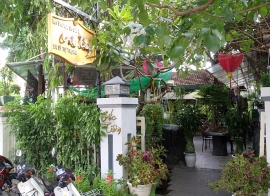
The town has a number of cafés with shaded courtyards. This looked super inviting as we peered in under the scorching sun.
We had a hard time getting any cafes that would accept US dollars and ended up having to find an ATM machine first in order to join the café culture – in the shade…
PHU MY (HCMC), VIETNAM
Another one of those remote gateway ports, Phu My is a 4-hour roundtrip bus ride from Ho Chi Minh City (aka Saigon), leaving little meaningful time to explore the teeming metropolis. Luckily we’ve been to HCMC. Having toured the Chu Chi Tunnels, seen the Ben Thanh Market, and acquired the requisite (probably fake) Weasel Coffee, we decided to explore the town of Ba Ria close to the port instead.
The banh mi’s airy, crispy crust, coupled with the explosion of flavors between juicy savory meats and assorted pickles makes an incredible afternoon snack.
The sun at high noon starkly highlighted the metal railing of the church ramp.
The drain cover for the Catholic Church is surprisingly decorated with traditional Chinese motif of bats to attract good fortune – an interesting case of cross cultural assimilation.
Sometimes it’s hard to think about Rudoplph and other trappings of X’mas when you’re practically melting in a subtropical country. It was somewhat surreal to see poinsettias in the sidewalk shop.
We missed out on a Nha Trang specialty called Bun Cha Ca. The rice noodles are served with steamed sailfish and jellyfish. The distinctive sweet and flavorful broth is from fish bones instead of traditional pork bones. Maybe next time…
Destination Asia: Of Dragons & Spice and Everything Nice – Nagasaki & Shanghai
NAGASAKI, JAPAN
As the main foreign trading port throughout the island nation’s history, and one of the cities destroyed by the atomic bomb during WWII, Nagasaki has plenty to see for a day trip. But since I love penguins, I decided to visit the somewhat obscure Penguin Aquarium before heading to the Atomic Bomb Museum and Peace Park in the afternoon.
The Nagasaki Penguin Aquarium exhibits 8 of the 18 penguin species found world-wide. It pioneered the program ‘With Penguins on the Beach’ where its captive Humboldt penguins are able to swim in the ocean secured by fences and nets. It was fun to see them waddle out with their handlers to the beach and take their ‘constitutional’!
Nagasaki Champon is a popular offering among restaurants in Chinatown. Since Japan is the land of ‘incredible inedibles’, the food replicas were ubiquitous at restaurant windows.
Of Chinese origin, the noodles were served with vegetables, shrimp, squid and scallops in a rich pork broth. The steaming bowl of ramen was definitely Delicious and Nutritious!
The Park serves as a stark reminder of the city’s destruction by nuclear explosion with a museum, memorials, and statues. We toured the Nagasaki Bomb Museum, a somber testament to the death and suffering unleashed by the Fat Man on August 9, 1945.
SHANGHAI, CHINA
To make the best use of our time, we decided to book a Shanghai Back Street Tour with a local guide to start our day. This provided us with insider tips on the best dumpling restaurant and street food in the ‘hood. Similar to Beijing, Shanghai’s historic hutongs are being demolished at an alarming clip. Our tour was a step back in time, a chance to see the historic alleyways before they become a historical footnote.
Along the way, we got some sweet roasted chestnuts and scrumptious jianbing (aka Chinese breakfast burrito!) with the help of our guide. We ate at a local restaurant popular for its xiaolong bao, Shanghai’s famous soup dumplings, and avoided the long lines at trendy dumpling restaurants.
There was just enough time after lunch for a quick dash around Yuyuan, the exquisite Ming-era garden designated as a National Monument by the Chinese government, then it was time to head for the cruise shuttle and return to the port.
I didn’t have a chance to see the Bund’s Colonial architecture, ride the ferry for panoramic views of new and old Shanghai, or visit any of the quaint Water Towns nearby, but I know I’ll be back!
We visited some hutong homes with our guide to get up close and personal with their long time residents and experience this vernacular architecture firsthand.
This house hung a mirror PLUS a pair of scissors to mitigate the bad feng shui of its location in the alley.
This reminded me of the laundry practices in Antibe’s Old Town which we visited the year prior. Maybe it’s the laundry, but somehow it looks less charming here…
Thanks to our guide, we got our crispy ‘Chinese Breakfast Burrito’ from the best jianbing stall in Shanghai. Different from other stands, this vendor has a turntable for making his crepes.
Batter is spread on the turntable, then eggs and a variety of toppings are added in succession. When the bottom crisps up, it is folded, and a special sauce of hoisin, red bean and chili paste are spread onto it. A piece of fried pastry is added last to give the characteristic crunch amidst the soft layers of the crepe. The jianbing is chopped into 2 halves and it’s good to go!
At about 50 cents each, jianbing is a filling and tasty made-to-order breakfast!
Yuyuan is renowned for its beauty as a classical Ming garden. However that also means it’s mobbed by group tours. Luckily I was able to snap some well timed shots of the pavilions and corridors.
I love minority tribe costumes and saw this beautiful silver headdress and jewelry, probably of Miao origin, on display inside Yuyuan.
As we were leaving Yuyuan, I decided satisfy my hankering for stinky tofu. The deep fried fermented bean curd is crispy on the outside and creamy on the inside. Common in Hong Kong, China and Taiwan, it’s not as much an acquired taste (it tastes good), but you need to ignore its deadly smell. Suffice to say Andrew Zimmern of Bizarre Foods flubbed it.
I love stinky tofu mainly for its accompanying sweet sauce but sadly, unlike the Hong Kong version, it only comes with chili sauce in China…
Destination Asia: Of Dragons & Spice and Everything Nice – Beijing & Busan
Once in a while, I come across travel deals I can’t resist. Our recent 16 night SE Asia cruise was one such example. Covering 9 ports and 6.5 countries (I’ll consider Hong Kong a separate entity until it officially comes under the Motherland’s rule in 2047) it was a kaleidoscope of sights, tastes and smells that affirms Asia’s reputation as an exotic destination. Come with me to see some of the most colorful and vibrant countries on that continent!
BEIJING, CHINA
Since we had already toured the Imperial Palace, hiked the length of Mutianyu Great Wall and trolled through the Wangfujing Night Market on a prior trip, we only planned on a 2 night stay in Beijing before the cruise. This gave us just enough time to explore the Summer Palace, meander around Houhai’s boutiques and pig out on Peking Duck & venison – just enough to whet our appetite for another visit to this brash and dynamic capital of the Middle Kingdom!
The Summer Palace built by Qing Emperor Qianlong for his mother, the Empress Dowager Cixi, is as extensive as it is lavish. Designated as a World Heritage site for its Chinese landscape design, it masterfully integrates scores of palaces, temples, pavilions, corridors and bridges harmoniously into the surrounding hills and lakes.
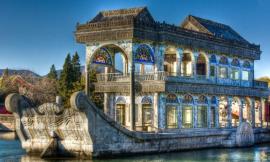
The boat that sank the Chinese Navy – this is the infamous Marble Boat built by Cixi to drain the treasury of money intended for modernizing the Chinese navy, sealing the fate for the country’s decline.
Having always imagined it to be an extravagant monstrosity, I was surprised to see the modestly sized reproduction steam paddle boat. Undoubtedly a lot of the money ended up lining the pockets of the court officials – either that or the Chinese Navy budget was a mere pittance…
Ironically the Marble Boat is so heavy it would have sunk like a rock (or ton of marble?!). The wooden top storey was a later addition, decorated with colored glass and mirrors positioned to give an illusion of it being afloat.
We ate at Dadong the first night. It was hard to find but totally worth the effort. The Beijing duck’s thinly sliced skin was sublimely crisp and it was fun using all the condiments, buns and wraps, apparently de rigueur for proper consumption of THE DUCK at this restaurant. The menu was innovative and presentation was beautiful.
We were happily surprised by a couple of complimentary desserts at the end of dinner (communication and service are still lacking in China): sweet black sesame drink and a platter of jujubes, cantaloupe and watermelon slices artfully presented on a bed of dried ice.
Hutongs are maze-like neighborhoods of narrow alleys formed by adjoining courtyard homes and have been the fabric of life for generations of Beijingers.
Pedicab tours give visitors a glimpse into the traditional way of life that is fast disappearing under the bulldozers’ tracks.
We chanced upon a new branch of Quanjude, a major Beijing Duck chain, in Houhai. Granted the duck was not as lean and crispy as Dadong’s, but the menu was cheaper and there was a free Chinese variety dinner show, so it offered reasonable value. Venison seemed to be ‘in’ as it was on the menu both nights.
It’s best to stick with duck dishes – our sautéed Bambi reminded us of the song Hotel California: we stabbed it with our steely knives but just couldn’t make a dent in the leathery beast!
Known for its cafes, bars, and hutongs, Houhai was gentrified for the Olympics and the main drag is now chock full of retail and entertainment establishments in make-believe traditional Chinese architecture.
Music from each establishment is piped out to the patio and becomes a virtual ‘battle of the speakers’ as each bar seeks to outdo its neighbor in decibels.
There are still traditional homes around. These came from a house in the hutong where our Courtyard Hotel was located.
BUSAN, KOREA
Our first port was Busan in South Korea. We decided to check out the local street food scene and wandered around the stalls. Most of the offerings were fried – not exactly healthy but piping hot and very tasty. We chose to queue up on the longer lines as the locals obviously know which vendors are the best!
On the other hand, if shopping is your pleasure, extensive underground malls link several subway stations together so you can shop and walk around town in comfort regardless of the weather. We strolled between 2 subway stations but found much of the merchandise catering to young people.
This is one of a series of drawings on the siding surrounding a construction site. This is so much more refreshing than billboards and ads!
From griddle pancakes to deep fried whole fish, food was everywhere in the streets surrounding the Jagalchi Fish Market.
The Fish Market is housed in this surprisingly contemporary structure. We couldn’t have guessed what was inside this massive pier side edifice.
There are stalls selling all manner of seafood, fresh or dried, as far as the eye can see.
The second floor is a food court with some eateries featuring live seafood where you can pick your own slab o’ protein protein fresh from the tank!
Best of 2011 – Retrospects from 2 Parallel Universes
Since it’s the beginning of a new year, this is a great time to acknowledge some of the most interesting happenings or products from 2011. As a twist, I’ll be presenting both the ‘World View’ and my personal alternative perspective!
1. Exemplary Interiors
Tori-Tori, one of the best Japanese restaurants in Mexico City, was winner of Interior Design magazine’s 2011 Best of Year Award for fine dining. The vibrant color and organic shape of the façade caught my eye. The project was built from the ground up and each dining space sports its own collection of custom furniture to enhance the diner’s experience.
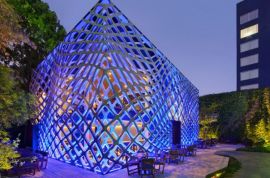
The organic shape of the façade is created from two self-supporting layers of steel plates cut with a CNC machine.
Dubbed as the House of the Flight of Birds, the two wings of this home with their undulating rooflines bear remarkable resemblance to a pair of stylized birds. I love how architect Bernardo Rodrigues integrated the form of the house with its interior details so both elements reinforce his vision of the space.
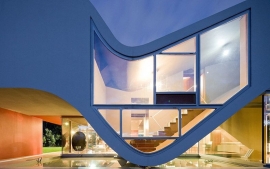
Covered courtyards and patios on the ground floor shelter the living spaces while the staircase to the roof top terrace traces the curvilinear form of the building.
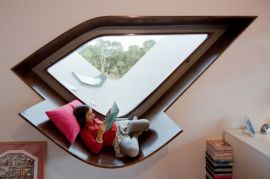
The window ‘sling’ is a perfect example of Rodrigues’ attention to detail when designing the interiors of the space.
2. Green Light For Green Lighting
Since I write so much about lighting, it’ll be hard to close out the year without picking an eco friendly light fixture.
The award winning Plumen 001 light bulb has its merits – and at $35, is probably the cheapest designer lighting product on the market.
The lamp exudes a raw, industrial aesthetic, but I find the lamp a bit too ‘in my face’. However it’s supposed to provide almost 60W of light from an 11W bulb and lasts about eight years, so it’s a great choice if you want an energy efficient light bulb that makes a statement!
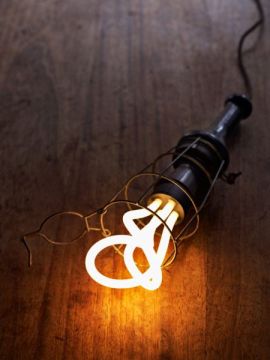
The light bulb is over 7" long and over 4" wide so it looks best in ‘bare’ sockets - considering it won’t fit inside a lot of lamp shades.
I personally prefer a more refined look. Aqua Creations unveiled a beautiful series of LED light fixtures, each of which are hand crafted from a single sheet of paper. The origami lamp casts a soft, delicate glow and will provide quality ambient lighting in any space.
3. The Travel Bug
As Rick Steves aptly puts it ”There are travelers and there are tourists. There is travel and there is hedonism.”
Billed as Editor’s Choice for Alternative Reality by travel writer Gary A. Warner, Las Vegas makes an easy weekend getaway. Considering all the action on and off the Strip, it certainly belongs to Rick’s latter category!
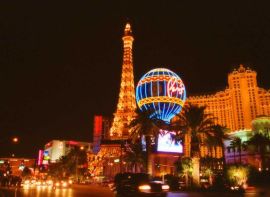
Paris, Las Vegas, by night. If canals are more your style, just mosey along the Strip to the Venetian...
I spent 3 weeks last winter in SE Asia, part of which was on a cruise. It was a whirlwind tour of China, Japan, Korea, Hong Kong, Vietnam, Thailand and Singapore.
The good thing was that I was able to visit my family in Hong Kong, albeit for just a day – the roundtrip plane ticket would have set me back about $1300 in what I jokingly call ‘Marsupial Class’!
On the other hand, I found out that unlike cruising in other parts of the world, a lot of the ports in SE Asia are an hour or more from the cities of interest. Most of the big ships have to be docked at deep water container ports which are nowhere near centers of civilization. The ports for Beijing, Shanghai, Ho Chi Minh City (Saigon) and Bangkok are a couple hours away depending on traffic, and even Hong Kong and Nha Trang (Central Vietnam) require extended transfers to reach their town centers.
Despite the logistics issues, we steadfastly avoided the ship’s group excursions and experienced each country’s people, food, culture and religion through its local markets and street food stalls.
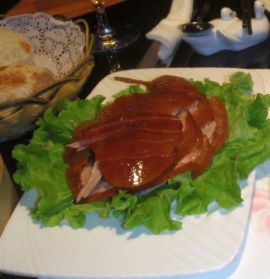
My favorite dish in Beijing. It was love at first bite – the glistening and crispy skin of the Peking duck at Da Dong Roast Duck Restaurant was absolutely addictive!
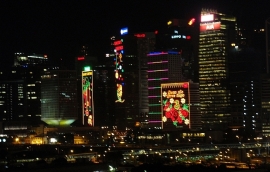
Festive night scene of Hong Kong as the ship sailed past the harbor. The waterfront buildings are usually lit up like a Christmas tree (can’t resist the pun!) for the holidays.
4. Food for Thought
While I’m not a fan of sugary fried dough, apparently fancy donuts are making a comeback!
Check out these ‘designer doughnuts’ – Gourdoughs in Austin has glazed versions topped with grilled bananas & cream cheese icing with brown sugar. Frittelli’s of Beverly Hills offers gianduja and orange cranberry, while Federal’s in Philadelphia features fried concoctions of pina colada and vanilla lavender.
Gourmet cupcakes seem to have made their run, while more and more mararons are debuting in upscale bakeries these days: even the renowned Parisian patisserie Ladurée opened its first stateside store in New York City last year.
In fact I saw not one but two shops selling these delectable treats at the Marina Bay Sands Resort in Singapore last year, one of which was owned by Jean-Philippe Darcis, the first Belgian chocolatier to win the accolade “Ambassador of Belgian Chocolate”. I soooo miss the yummy-licious macarons from L’Atelier Jean-Luc Pelé in Cannes!
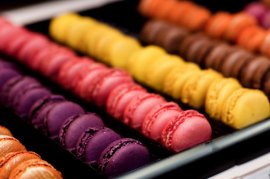
Macarons come in a rainbow of colors with sublimely creative concoctions such as passion chocolate, strawberry poppy, white chocolate coconut, foie gras with sea salt caramel and citron vert vodka…
5. It’s not Lady Gaga…
Of course the fashion event of the year for the world was Kate Middleton’s wedding dresses at the Royal Wedding to Prince William. I was busy with work so never followed the celebrations very closely, but it gave me flashbacks of Princess Diana’s storybook wedding to Prince Charles so many years ago…
For me, the fashion event of the year was being part of the Designer Challenge fashion show.
Put on by my professional organization, the CA Peninsula Chapter of the American Society of Interior Designers, teams of interior designers are given randomly drawn interior design materials (upholstery and window fabrics, trimmings, tiles and wallpapers) 90 minutes before the start of the fashion show. The challenge is to design and fabricate a ‘couture’ garment without using a sewing machine within a short 1.5 hours.
I met up with my team, Haute Rags, the afternoon of the show. Luck of the draw landed us an unusual snake motif fabric, which became the inspiration of our design. Once the outfit was sketched out, we worked fast and furious to turn our vision into reality in our remaining hour.
Absolutely clueless about the art of tailoring, I was kept busy and out of trouble assembling the garment while others created dress patterns on the fly. Work was feverish but a total blast and I have to say guns (hot glue and staple), not diamonds, were my best friends that night!
